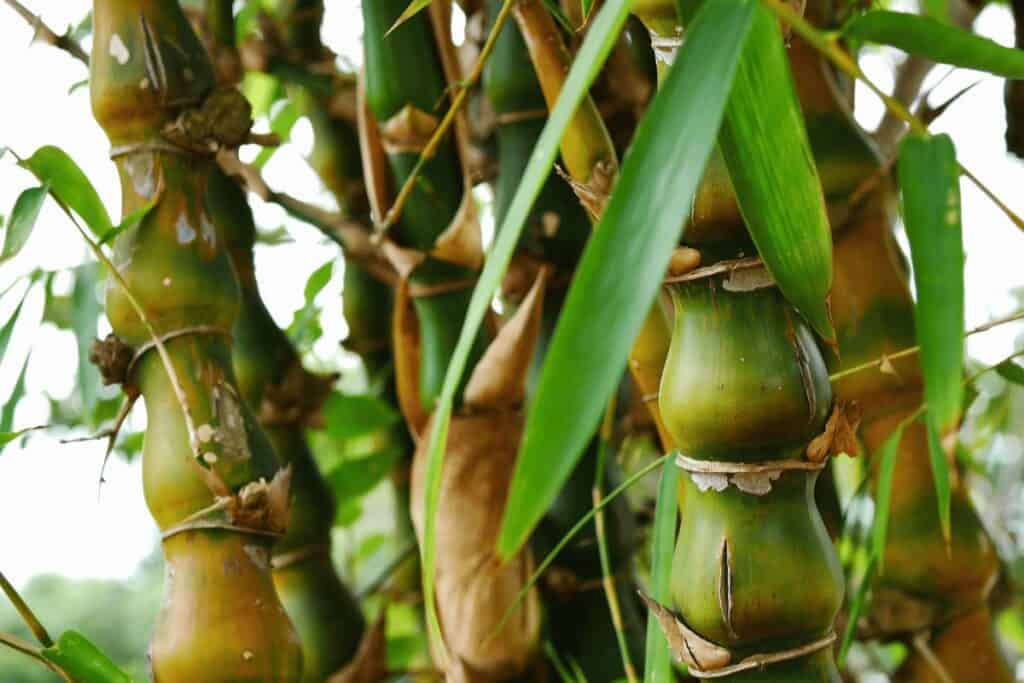How to Grow and Care for Golden Bamboo Indoors, Golden bamboo, also known as Phyllostachys aurea, is a beautiful and versatile plant that can be grown indoors with the right care and attention. With its golden-yellow canes and lush green leaves, golden bamboo adds a touch of tropical elegance to any indoor space.
In this guide, we will cover everything you need to know about growing and caring for golden bamboo indoors, from choosing the right environment to planting and potting, watering, feeding, pruning, and maintenance.
Whether you’re a seasoned gardener or just starting out, you’ll find this guide to be an invaluable resource for growing a healthy and thriving golden bamboo plant indoors. So, let’s dive in and discover the secrets to success with this wonderful indoor plant!

Golden Bamboo Has several Benefits
Some of these benefits include:
- Air Purification: Golden bamboo is known for its air-purifying qualities, removing harmful pollutants from the air and improving indoor air quality.
- Stress Relief: The tranquil and calming effect of golden bamboo is said to help reduce stress and promote relaxation.
- Decorative Appeal: Golden bamboo’s stunning golden canes and lush green leaves make it a visually stunning addition to any indoor space, adding natural beauty and style to your home or office.
- Low Maintenance: With the proper care, golden bamboo is relatively low maintenance, making it a great choice for busy gardeners or those with limited gardening experience.
- Easy to Grow: Golden bamboo is relatively easy to grow, as long as you provide the right environment and care. With the right conditions and care, golden bamboo can grow up to 3 feet per year, making it a fast-growing and attractive indoor plant.
- Versatile: Golden bamboo is suitable for a range of indoor settings, from homes and offices to conservatories and greenhouses. It can be grown in a container or as a standalone plant, making it versatile and easy to fit into any indoor space.
These benefits make golden bamboo a great choice for indoor gardening, whether you’re looking to improve the air quality of your home, add a touch of natural beauty, or simply want a low-maintenance indoor plant. With the right care and attention, golden bamboo can thrive indoors, providing you with years of enjoyment and benefits.
Purpose of This Article on How to Grow and Care for Golden Bamboo Indoors
The purpose of this guide is to provide a comprehensive and easy-to-follow resource for growing and caring for golden bamboo indoors. The guide covers all the key aspects of growing golden bamboo, from choosing the right environment and planting, to watering, feeding, pruning, and maintenance.
Whether you’re an experienced gardener or just starting out, this guide will give you the knowledge and confidence you need to grow a healthy and thriving golden bamboo plant indoors. Whether you’re looking to purify the air, add a touch of natural beauty to your home, or simply enjoy the calming and relaxing effect of this wonderful indoor plant, this guide is your ultimate resource for growing and caring for golden bamboo indoors.
Understanding the Basics of Golden Bamboo
A. Origin and Species of Golden Bamboo: Golden bamboo, also known as Phyllostachys aurea, is native to China and is a member of the Poaceae family. It is a popular indoor plant due to its unique golden-yellow canes and lush green leaves.
B. Characteristics and Features of Golden Bamboo: Golden bamboo is a fast-growing plant that can reach up to 60 feet in height when grown outdoors, but typically stays smaller when grown indoors. The golden-yellow canes are a distinctive feature of this plant, and the lush green leaves provide a backdrop of lush greenery. The plant also produces small, inconspicuous flowers, which are followed by small, edible bamboo shoots.
C. Different Types of Golden Bamboo: There are several different types of golden bamboo, including Phyllostachys aurea, Phyllostachys aureosulcata, and Phyllostachys aureosulcata ‘Spectabilis’. Each of these species has its own unique characteristics and features and can be grown indoors with the right care and attention.
When choosing a type of golden bamboo, consider factors such as the size, light requirements, and growth habits of the plant, and choose a species that will thrive in your indoor environment.
25 Seeds Golden Groove Bamboo

Seeds Phyllostachys Aureosulcata Aureocaulis Non-Hybrid, Open-Pollinated
- 100% NON-GMO: All our seeds are Non-GMO. The seed stock was grown up in fertile soil in clean.
- Heirloom, and Non-GMO Our goal is to provide you with excellent products. We maintain high-quality standards and sell only quality seeds. The seeds you receive are a high-quality product, that was grown on the fertile black soil in Ukraine and only in Eco-zones. To share the astonishing magic of nature, we are offering vegetables and plants for all growing zones and all seasons
- All of the seeds contained within this assortment are fresh and are intended for the current and the following growing seasons. Each seed collection is sealed within a nylon package.
Choosing the Right Environment for Golden Bamboo
A. Ideal Temperature and Humidity Conditions: Golden bamboo prefers a warm, humid environment, with temperatures ranging from 60-85°F. It is important to maintain a consistent temperature, as sudden temperature changes can cause stress to the plant. High humidity levels are also important for golden bamboo, and a humidity level of at least 50% is ideal. If the air in your home is dry, you may need to use a humidifier or mist the plant regularly to maintain the proper humidity levels.
B. Proper Lighting Requirements: Golden bamboo needs bright, indirect light to thrive. Place your golden bamboo near a window that receives bright, indirect light, or uses artificial lighting if necessary. It is important to avoid direct sunlight, which can cause the plant to become overheated and stressed.
C. Soil Type and Drainage: Golden bamboo prefers well-draining soil that is rich in organic matter. A good quality potting soil mixed with perlite or sand can help ensure proper drainage. Make sure to choose a pot with adequate drainage holes to prevent water from becoming trapped in the soil, which can lead to root rot. It is also important to avoid over-watering, which can cause waterlogged soil and harm the plant’s roots.
Planting and Potting
A. How to Propagate Golden Bamboo: Golden bamboo can be propagated from cuttings or division of the root system. To propagate from cuttings, take a cutting from an established plant and plant it in a pot with well-draining soil. To propagate by division, carefully remove the golden bamboo from its pot and divide the root system into smaller sections, planting each one in its own pot with fresh soil.
B. The Best Soil Mixture for Golden Bamboo: A good quality potting soil mixed with perlite or sand can help ensure proper drainage for golden bamboo. You can also add a small amount of organic matter, such as compost or well-rotted manure, to improve the nutrient content of the soil.
C. Choosing the Right Container: When choosing a container for your golden bamboo, look for a pot with adequate drainage holes and a size that is appropriate for the size of your plant. A pot that is too small will restrict the growth of the plant, while a pot that is too large can lead to over-watering and root rot.
D. Tips for Planting Golden Bamboo: When planting golden bamboo, make sure to plant it at the same depth as it was growing in its previous container. Water the plant well after planting, and place it in a location with bright, indirect light. Over the next few weeks, monitor the plant for signs of stress and adjust its care as necessary to ensure its health and well-being.

Watering and Feeding Golden Bamboo
A. How Often to Water Golden Bamboo: Golden bamboo should be watered regularly, but it is important to avoid over-watering. The frequency of watering will depend on the size of the pot, the type of soil, and the local climate. As a general rule, the soil should be kept evenly moist, but not waterlogged. Check the soil moisture level regularly by inserting your finger into the soil to a depth of 2 inches. If the soil feels dry, it’s time to water.
B. How to Prevent Overwatering: Overwatering is one of the biggest threats to golden bamboo. To prevent over-watering, make sure to choose a pot with adequate drainage holes and a well-draining soil mixture. It is also important to avoid watering the plant too frequently and to allow the top inch of soil to dry out slightly before watering again.
C. Best Fertilizers for Golden Bamboo: Golden bamboo benefits from regular fertilization, especially during the growing season. Use a balanced, water-soluble fertilizer every 4-6 weeks during the growing season, following the manufacturer’s instructions for application rates. You can also apply a slow-release fertilizer once a year in the spring to provide long-term nutrition to the plant. In addition to fertilization, golden bamboo also benefits from occasional misting with a soluble, seaweed-based foliar fertilizer to promote healthy growth.

Pruning and Maintenance
A. The Importance of Pruning Golden Bamboo: Pruning is an important part of caring for golden bamboo. Regular pruning helps to maintain the plant’s shape, encourages bushier growth, and can prevent the plant from becoming too tall and leggy.
B. How and When to Prune Golden Bamboo: Pruning can be done any time of the year, but the best time to prune golden bamboo is during the spring when new growth begins. To prune golden bamboo, simply remove any yellow or dead leaves, as well as any shoots that are growing in an undesirable direction. You can also pinch back the tips of the shoots to encourage bushier growth.
C. Common Pests and Diseases and How to Control Them: Golden bamboo is relatively resistant to pests and diseases, but it is still important to keep an eye out for common problems such as spider mites, mealybugs, and fungal diseases.
To control pests, wash the leaves regularly with a mild soap solution and spray the plant with neem oil. For fungal diseases, remove infected leaves and avoid watering the plant from above, which can encourage the spread of the disease. If you have trouble controlling pests or diseases, consult with a local nursery or gardening expert for advice.
Conclusion
A. Recap of Key Points: In this guide, we have covered the basics of growing and caring for golden bamboo indoors, including its origin and species, the ideal growing environment, planting and potting, watering and feeding, pruning and maintenance, and common pests and diseases.
B. Final Thoughts and Recommendations: Golden bamboo is a beautiful and versatile plant that is well-suited to indoor growing. By following the tips and guidelines outlined in this guide, you can enjoy healthy, lush golden bamboo in your home for years to come.
C. Encouragement to Try Growing Golden Bamboo Indoors: Whether you are an experienced gardener or a beginner, growing golden bamboo indoors is a rewarding experience. With its graceful, bamboo-like appearance and air-purifying qualities, this plant is a wonderful addition to any home or office. So why not give it a try? We’re confident that you will be thrilled with the results!
FAQs
Q: How long can bamboo stay in pots?
A: Bamboo can stay in pots for several years, as long as proper care is given and the pot size is appropriate for the size of the plant.
Q: How fast does golden bamboo grow?
A: Golden bamboo can grow several feet in a year, depending on the growing conditions and care given. It is considered a fast-growing species of bamboo.
Q: How deep do golden bamboo roots go?
A: Golden bamboo roots can grow several feet deep, depending on the variety and growing conditions. It is important to choose a container with appropriate depth to accommodate the roots.
Q: How long does it take for golden bamboo to grow?
A: Golden bamboo can take several years to reach its full height, depending on the growing conditions and care given.
Q: Is golden bamboo clumping or spreading?
A: Golden bamboo is a clumping species, meaning it does not spread aggressively like some other species of bamboo.
Q: Will golden bamboo spread?
A: Yes, golden bamboo can spread through underground rhizomes, but it is not considered an invasive species. It is a clumping bamboo that will not spread aggressively.
Q: What is interesting about golden bamboo?
A: Golden bamboo is known for its striking yellow culms (stems) and fast growth rate. It is also prized for its ornamental value as an indoor plant and its ability to purify the air.
References
A. List of Sources Used in the Guide:
- The Bamboo Garden: “Golden Bamboo (Phyllostachys aurea) Care Guide”
- https://pluckgrain.com/bamboo-palm-indoor-plant/
- Costa Farms: “Golden Bamboo Plant Profile”
- Gardening Know-How: “Growing Golden Bamboo Indoors”
- Better Homes & Gardens: “Golden Bamboo: A Guide to Growing and Care”
B. Additional Reading Resources for Golden Bamboo Care:
- The Spruce: “Golden Bamboo: A Guide to Growing and Care”
- BBC Gardeners’ World: “Golden Bamboo: A Guide to Growing and Care”
Latest Posts
- What Types of Lettuces Can You Grow?

- How to Plant Onion Seeds for Maximum Germination

- How to Plant Parsnip Seeds for Maximum Germination

- How to Plant Mushroom Seeds for Maximum Germination

- How to Plant Lettuce Seeds for Maximum Germination

- How to Plant Kale Seeds: A Step-by-Step Guide to Maximum Germination Success!





